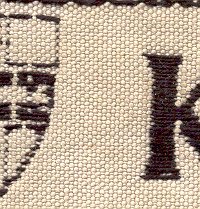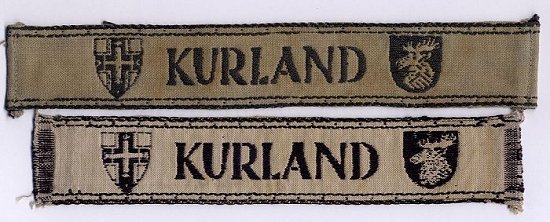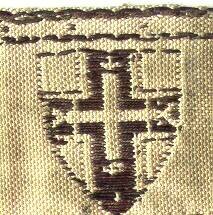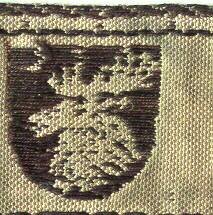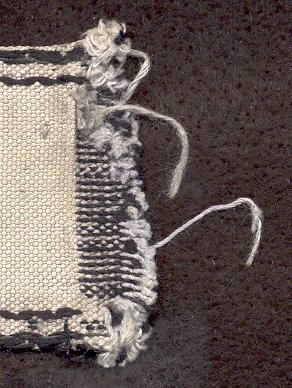
By Scott Pritchett
KURLAND CUFFBAND
The KURLAND cuffband was the last such award approved, designed and issued by the Wehrmacht. It was designed and instituted at the request of Generaloberst von Vietinghoff who commanded Heeresgruppe Kurland at that time. Examples of the band itself are scarce. Authentic award documentation is very rare. Photographs of the cuffband in wear are yet more difficult to find. Unpublished photos were even more difficult to locate.
Awarding and Criteria
The criteria to qualify for the award were simple. A service member had to have participated in three engagements or sustain a wound. There was also a time period of three months of service required for those soldiers not directly engaged in combat.
As noted earlier, the KURLAND band is also virtually the only cuffband that broad numbers of Wehrmacht soldiers from across the service branches were qualified to receive. Modern collectors of Heer, Luftwaffe, Waffen SS and Kriegsmarine all would have interest in this award. There are several recognized versions of the cuffband, which can pose a challenge for collectors. Only one version is easily recognized as authentic. In writing this article, I sought out many collectors for confirmed examples of authentic variations and had significant difficulty.
Cuffband Types
Authentic KURLAND cuffband styles can be grouped in to two categories: those manufactured within the bridgehead and those manufactured outside the bridgehead (in Germany mainly). Technically, there was only one official version. This would be the full-length style produced and issued in Germany. Many of the scarce contemporary photos showing the cuffband in wear, tend to show what looks to be the full-length version made in Germany. Many of these photos are of Wehrmacht members that were probably either evacuated from the pocket individually for various reasons (wounds, reassignments, leaves, etc) reassigned as individuals or reassigned with their units to other battlefields or areas. Kreigsmarine and Luftwaffe personnel would have had the best opportunities for getting to Germany as individuals.
To collectors however, the locally made style tends to be recognized as the "official" cuffband and is most often found in original form on the collector market today. This style came about when, after the 12 March 1945 order directing its establishment, Heeresgruppe Kurland took it upon itself to locally manufacture the award. It is certain that the reason for this decision was the prevailing conditions of isolation of the army group coupled with the pride and morale impacts of being able to reward the soldiers who knew they would be required to fight on in spite of their predicament. The main manufacturing source was apparently located in a weaving mill in the city of Kuldiga, Latvia. While a concern existed for the shortages of material to weave the cuffbands, the fact that the locally manufactured version is short may have also been a decision based on a September 1944 OKW directive stating that to conserve materials, all cuffbands and cufftitles would henceforth be made 22 cm long (versus an heretofore standard length of about 35-40cm). Sources contain conflicting information as to when it actually began to be issued. One such source states after the third battle - which would have taken place in November- December 1944. Other sources state March 1945. Taken at face value, neither would necessarily be wrong, as March 1945 was in fact after the third battle. But, with the official institution being 12 March 1945, it would seem unusual that it could have been issued as early as January or February 1945. No information has surfaced which documents the date of local manufacture. Research indicates that there are two possibilities for when the cuffband began to be awarded and issued: (1) word and description of its institution preceded its official institution in March 1945 - which is entirely possible based the administrative process and the fact that the published order is really only the administrative benchmark - and thus local production and issuance could have begun earlier than March 1945 or (2) those who were able to fly or ship out of the bridgehead after November-December 1944, received their official cuffbands around/after March 1945. Two pictures in Williamson's and McGuirls's book on cuffbands of Majors Toni Müller and Sepp Brandner, both Knights Cross winners, give more clues. Both are shown in portrait shots with their oakleaves and sporting the KURLAND band. Müller's may be a printed, full-length version and Brandner's may be the machine woven style (length unknown). Müller was awarded his oakleaves on 14.2.45 and Brandner on 26.4.45. Additionally, Brandner received the CCC in Silver on 11.4.45, but is pictured still wearing the Bronze CCC. It is likely both men exited the pocket at different times to receive these awards, but the photos had to be taken after the issuance of the cuffband, as both are photographed wearing one...indicating that Müller's photo occurred a couple months after his oakleaves were awarded and on another separate trip out of the pocket. And, since Brandner did not even receive the Knights Cross until 17.3.45 (interestingly a week after the KURLAND band was instituted), it seems probable that these portrait photos were made late March '45 to early April '45, indicating that cuffbands were available at this time - certainly outside the bridgehead, but most likely inside as well. Brander is not known to have left the pocket again, and in fact refused to, surrendering with his men to the Soviets on 9 May 1945. Additionally, many of the entries in soldiers' Soldbuch and Wehrpaß books, as well as on award documents, commonly show the date of 20 April 1945 as a date of awarding. No dates earlier April 1945 were found, so the preponderance of evidence supports awarding on or after the 12 March 1945 institution date. This would leave about a sixty day period in its life span - and helps explain its all around rarity. Please see the documents section below for additional information regarding awarding.
Regardless of the location of manufacture or the particular style, all KURLAND bands have the same basic design motif. The word KURLAND appears on a sliver-white background cloth in bold, black, linotype lettering, centered between - on the left - the coat of arms of the Hochmeister (Grand Master) of the Teutonic Knights, and - on the right - the city coat of arms of the city of Mitau, a major historical city in the Courland area of Latvia. The cuffband is lined top and bottom with black border.

Courtesy Jim Pool Collection.
Detailed Description of the Locally Manufactured Version:
There are probably a number of authentic, locally manufactured KURLAND cuffbands, as the varieties on the collector market are numerous. So numerous in fact that it is sometimes difficult to state authenticity based on any "standard". But, one that turns up relatively frequent on the collector's market, and thus can be said to probably be the most 'official' of the locally manufactured styles is the one pictured above. As this version is the most widely accepted and perhaps the most available to the collector, it is describe in detail and referred to as the "short style". Other types will be covered in less detail later.
|
|
||||||
|
Detail of the cloth's weave |
||||||
|
|
||||||
|
Two short style bands locally manufactured. Note the different
lengths. |
||||||
This short style KURLAND cuffband is machine woven, meaning that the design motif is woven in to the cloth as the band is made, rather than embroidered after the cloth is woven. The base cloth is frequently described as a silver-white. It in fact does yield visually a somewhat silver tint, but this is as much due to the shade of off-white thread used in the weave as it is to the fact that this white thread is woven as a facing color with black thread as a pattern color in order to produce the title design. The weave of the cloth on close inspection produces a very even pattern in a standard overlapping/basket style weave. The length of the Kuldiga/locally manufactured type is around 23 cm. Some bands are found with about .5 - 1 cm of this length on each end folded back under. Some have it fully exposed, but the intent was to fold it under. The band's width ranges from about 3.7 to 4 cm.
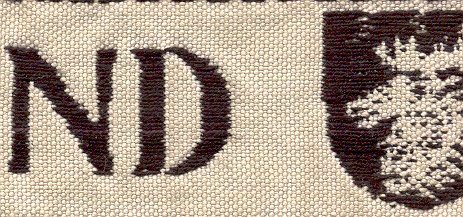 |
|
Detail of the cuffband letters showing the black threads running
consistently horizontal. |
All of the central motif of the design is woven in to the facing white thread of the cloth with a heavy black thread. This black thread runs only horizontal on an original and can be clearly seen with a close look, whether looking at the obverse or reverse. The letters are 16 mm in height and vary between 11mm and 13 mm in width. The U (10mm narrowest, 11 mm at the widest portion of the letter) and the L (7 mm at the narrowest portion and 11mm at its widest dimension) do not conform to the other letters in width. Typically, the strokes of the letters R, L, A, and D do not join/connect at all points
The shields are (left - The shield of the Grand Master of the Teutonic Knights) 25mm x 25mm and (right- the coat of arms of the city of Mitau) 24mm x 26 mm on the typical locally manufactured version. As in most Heer cuftbands, symbolism played a role in the design of the KURLAND band as well. Germany's history with the Courland region dated back over 700 years. The design of the KURLAND band was perhaps unique in the extent that its designers attempted to integrate this regional association. Other cuffbands, such as the AFRIKA and >KRETA< bands employed a similar design template, but the symbols that flank the title were not determined on history.
The left shield (pictured below), the coat of arms of the Grand Master of the Teutonic Knights is an interesting choice. Founded as the Teutonic Order in twelfth and thirteenth centuries, the Knights were one of the three Christian military orders - the others being the Hospitallars and the Templars. The black cross, added to the traditional white shield of medical orders, distinguished the Knights' order as a military-based organization. Initially associated with medical care during the crusades, and specifically battlefield medical care of German knights, the Teutonic Knights' became a fighting force whose power and influence ebbed and flowed over the next centuries. Constantly in search of a home since the crusades, the order resided from Jerusalem to Venice and eventually became most firmly established in the Baltic area of Europe during the Reformation. The nations of Poland and Lithuania, traditional enemies of the order, defeated it at Tannenburg in the fifteenth century, resulting in of most of what was then known as Prussia, being ceded to Poland and the order all but ceasing to exist. Under National Socialist Germany, the memory of the Teutonic Knights was used on propaganda to evoke an emotional connection for Germans of a Germanic warriors constantly embattled against the Slavic states of Eastern Europe, befitting of the more modern struggle for the Courland bridgehead against the Soviets.
|
|
|
Courtesy Jacques Calero collection. |
The right hand shield, the coat of arms of the city of Mitau - modern day Jelgava - was located about 30 km from Riga and was situated on the Drixa River. The city of Mitau was founded by the Teutonic Knights in the later thirteenth century. As already noted, Riga itself featured prominently with Heeresgruppe Kurland. Under the rule of the Teutonic Knights, Jews were never permitted to live within the city of Mitau. Later, in the sixteenth century when Mitau was under control of the Poles, Jewish merchants were allowed to conduct business within the city, but were once again expulsed by the seventeenth century when the area was taken over by the Cossacks. Thus, Mitau/Riga evokes a symbol of German dominion and ownership of the region as well as a degree of National Socialist pride.
|
|
|
Jacques Calero collection. |
The level of standardization of the two shields from cuffband to cuffband that collectors will encounter in this machine woven version - which are relatively complex designs on a cuffband - is such that the two pictures below accurately illustrate the main characteristics and detail.
 |
|
Scott Pritchett collection. |
The cuffband border on the locally manufactured version is not woven in to the cuffband, as is the rest of the design, but embroidered (machined) on the background cloth. Between the embroidered lines are black thread knots or dots. They are generally formed by two strokes of the thread - sometimes tightly together, sometimes distinct apart. Typically, about eighteen each of these dots are visible both on the top and the bottom border. They will not usually line up vertically/symmetrically between those in the top border and those in the bottom


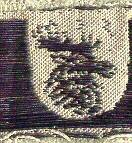 |
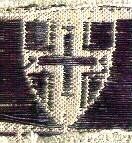 |
|
Four reverse photos of the KURLAND band showing the negative image, the top and bottom folds, the horizontal run of the black threads, frayed ends with salt and pepper weave to them, and the crispness of the detail of the shields - left image Jim Pool collection, right image and two close ups courtesy the Jacques Calero collection. |
|
|
|
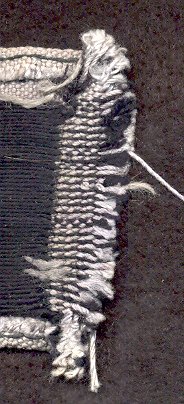 |
|
Detail of the front and back of the band ends, illustrating the salt and pepper weave of the ends. On the reverse the locking row of weaving can be discerned - Scott Pritchett collection. |
|
The reverse of the KURLAND band is the visual negative of the obverse. While the horizontal black threads used in the weaving will frequently look disheveled, the reverse image of the letters and the two shields are actually crisper than the obverse images. Above and below the letters are long lengths of black thread that generally anchor at the inside edges of the shield. The ends of the cuffband are always frayed and exhibit a distinct salt and pepper or a checkerboard weave pattern on just the portion which folds under - about a centimeter's worth - a key detail on an authentic band of this type. The ends, and thus the folds, are locked in place by the weaving process in a manner that looks as if the weave was doubled back on itself for a row or two. These sections were meant to be folded under and sewn to the uniform sleeve. The horizontal folds along the top and bottom edges - typically .5 cm worth - are likewise frayed but will not exhibit the salt and pepper weave present on the ends. They will, however show the reverse of the embroidered border lines, but NOT the dots. The outer most line of the double lined border will be observed on the outside of the reverse fold. One must lift up the fold to see the inner row or embroidery. Neither will look particularly clean, continuous and straight. The folds are held in place by the embroidery of the respective outer most horizontal top and bottom bands rows. Lifting up the horizontal folds will reveal the reverse of the embroidered dots as well. Loose threads on the reverse, but especially to the ends, corners and folds - both black and white - are not uncommon and should not be taken as signs of a reproduction.
Brief Description of the German Made, Full Length Style


Obverse and reverse of a full-length, machine embroidered cuffband that may be an example of the official award. This example was a vet acquisition form a POW camp in France. Many soldiers in units who qualified for the award were, as stated earlier, transferred out of the pocket to fight on other fronts before the surrender - Courtesy Mitch Miller collection
.

Obverse and reverse of another full-length style that is another possibility for being the officially awarded German manufactured piece. The photo shows the reverse folds turned back under. Also note the embroidery backing. The piece was acquired in 1989 in Germany - Courtesy Rick Carr collection.
No current literature used in research for this article illustrates a full-length cuffband and also clearly and unequivocally states that it the version manufactured in Germany prior to the war's end and intended to be the standard issue award. Both of the examples pictured are full-length versions that, if not the intended issue award, might have been something very close to it. Again, the wartime life span of the KURLAND cuffband could not have realistically been much more than 60 days. Certainly the leadership in Germany could not have known the war would end on 8 May, and would have generally proceeded with the manufacture of the band in a normal fashion. As in all German awards, care would have been taken to produce a quality piece, even at this late stage. The top examples are well made and exhibit many manufacturing characteristics of wartime cuffbands/cufftitles in general. A machine-embroidered style band would also most likely have been the product that was approved, and both of these are. One might expect to find black Russia braid as a border, since many cuffbands and cufftitles in the Wehrmacht (Waffen SS excepted) used this material. However, given the result of the style band made in Kuldiga, one must question if a complete deviation from past practices was not the intent and thus, the bottom style, with the checkered border was in fact the intended award piece. The border on this example may be symbolic of an unbroken chain, much like the troops of Heersegruppe Kurland or it could just be a stylized representation of soutache. Not knowing which came first, or if the design of the cuffband truly originated from within the bridgehead (it is reported to have been designed by soldiers within the Courland pocket) or from award designers in Germany (who would have been more likely to stick with "specifications") and approximated by Heeresgruppe Kurland, the lower example more closely agrees with the Kuldiga produced short style and points to the notion that it could be the issue style. The top example is probably the award piece and the different border on the short style, locally manufactured version is a stylized representation of Russia braid/soutache or what appealed to the Kuldiga weavers at the time.
![]()
© Copyright Wehrmacht-Awards.com LLC |
